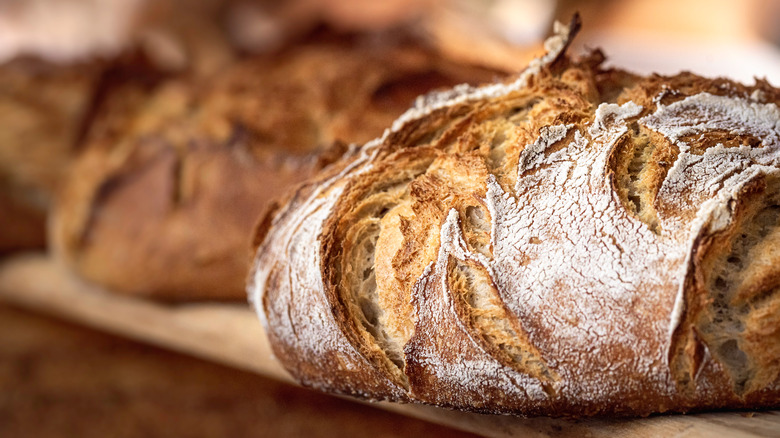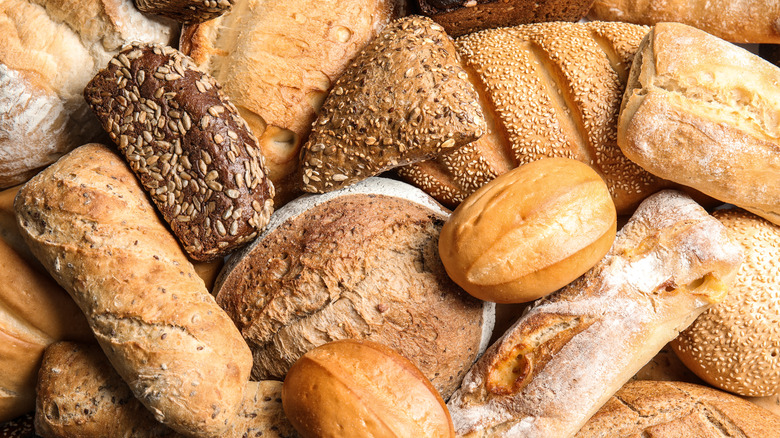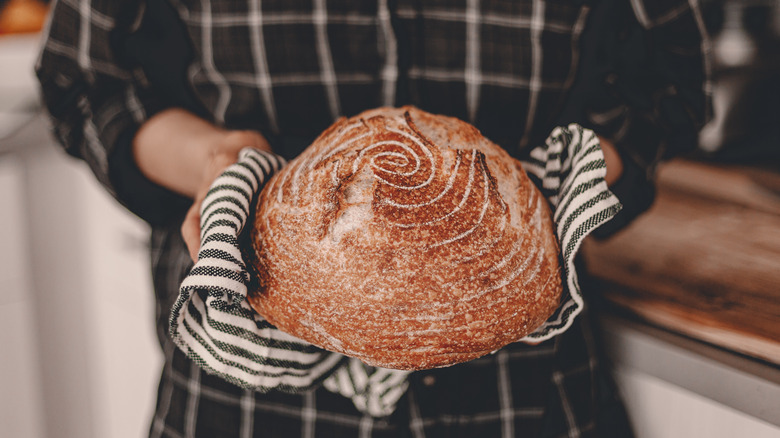Why Steam Is So Important When Baking Bread
Artisan bread still warm from the bakery is one of the world's simple pleasures. Seeing the shiny, golden-brown crust of a baguette peeking out of the paper bag is a sign that there's some true joy in your future. So, why is it so hard to produce the same quality of bread at home? Besides years of training and practice, one of the lesser-known reasons is the role that steam plays in bread baking (via King Arthur Baking). It's so important that those big commercial ovens are able to inject steam directly into the baking chambers. That steam is the key to creating the perfect crust on every boule that makes its way out their door.
Commercial ovens aren't typically accessible to the average home baker. Besides being incredibly large, they're expensive and don't make much sense for someone who only bakes a couple of loaves a week. Luckily, there are plenty of ways to get the same effects from a conventional home oven.
What role does steam play?
Steam plays such an important role in baking bread for several reasons, but essentially, it's helping your bread with its last stage of fermentation (via Slate). Fermentation is what makes the difference between good bread and great bread and can be one of the hardest aspects of baking to master, according to Food Network. The yeast that is added to your bread feeds on the sugars in the flour and produces gas that causes your bread to rise and loads it up with flavor as well (via BAKERpedia).
Slate explains that the last stage of this process and the first stage of baking is called the oven-spring. This is the point where the last of the yeast is producing gas rapidly thanks to the increased heat, and the bread gets its final lift before the yeast is killed off. The moisture helps the yeast and prevents the final crust from forming too soon. Slate notes that the surface of the bread stays elastic, which lets the dough further expand, and opens the interior or crumb to make it chewy and soft.
Once the yeast has died off and the steam evaporates, the dry heat of the oven causes a Maillard reaction as the crust forms. This adds even more sweet, caramelized flavor to the bread, and gives it that shiny, appetizing crust.
How to steam bread at home
King Arthur Baking recommends three methods to inject steam into a home oven. The first method is to take a simple spray bottle filled with water and spray the loaf lightly before it goes into the oven. The loaf will need a second spray about five minutes into the baking. This method is fairly easy to do, but King Arthur Baking found that it doesn't affect the final bread.
The second method the site recommends involves putting a preheated cast-iron pan on the tray under the loaf and fill it with about 1 cup of boiling water. That water should quickly evaporate, fill the oven with steam, and dissipate quickly enough for the loaf to finish under dryer conditions. King Arthur Baking also recommends placing a large metal bowl over the bread to keep the steam in close proximity. Just remember to leave a portion unsealed to let the steam in.
The method that King Arthur Baking found most effective is to bake your bread in a preheated dutch oven. This traps the natural steam released by the bread nearby and produces the most desirable color and blistering on the bread's crust.
Steam is just one step in perfecting the art of bread baking. Practicing these methods with a classic boule is a great first step before moving on to something like this delicious no-knead rosemary bread.


